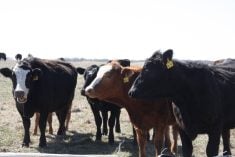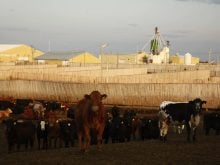This cattle market information is selected from the weekly report from Canfax, a division of the Canadian Cattlemen’s Association. More market information, analysis and statistics are available by becoming a Canfax subscriber by calling 403-275-5110 or at www.canfax.ca.
Fed prices drop
Last week the western Canadian fed market saw prices decline by $6 to $7 per hundredweight. Fed cattle prices are $6 per cwt. higher than last year but $8 per cwt. lower than 2020 and $5 per cwt. lower than 2019.
Read Also

Flax sector sees omega-3 opportunity
SASKATOON — A global shortage of omega-3 oils could be an opportunity for the flax sector, says an industry official….
A lot of the cattle hitting the market have breakevens on either side of $180 per cwt., suggesting losses are more than $350 per head. Competition on the cash market was limited with one packer not bidding. Even with rising COVID cases and many employees on five-day quarantine protocol (and longer in some instances), slaughter volumes came in larger than expected for the first week in January.
Dressed sales ranged from $260-$262 per cwt. delivered, and cattle that traded last week will not be picked up until mid-February. Alberta fed cash-to-futures basis levels weakened from -$12.46 per cwt. to -$15.62 per cwt., the weakest basis for the first half of January since 2009.
U.S. buying interest has been quiet. Import data of Canadian fed cattle showed an uptick in Canadian fed cattle volumes going south, but most if not all are contract cattle.
Ontario dressed sales were reported from $288-$293 per cwt. delivered, steady to $2 per cwt. lower than the previous week. Cattle that traded were for immediate delivery. Alberta fed prices are at an $18 per cwt. (live) discount to the Ontario market. Prices are getting close enough that Alberta cattle could start heading east for slaughter. Cattle from Manitoba and Saskatchewan are likely already heading that way.
In the United States, dressed sales in Iowa and Nebraska were at mostly US$218 per cwt., $1-$2 per cwt. lower than the previous week. Live sales in Texas and Kansas ranged from $135-$137, $1 per cwt. lower.
The all-fresh beef retail price for December was $7.35 per pound, two percent lower than November but 18 percent higher than last year. This is the second month in a row of lower retail beef prices.
Total U.S. beef exports for November were eight percent larger than last year. More beef was shipped to South Korea, Japan and China. Beef imports in November were 28 percent higher compared to last year. More beef was imported from Mexico and New Zealand.
Cow prices steady
Non-fed prices gained momentum last week with slaughter cow prices fully steady. D2s averaged $74.58 and D3s averaged $66 per cwt.
Dressed cow bids were generally steady, ranging from $142-$148 per cwt. delivered, but the market tone was sluggish. Salvage cows at auction traded widely on selective buying for different classifications. Butcher bull prices firmed almost $5 per cwt. higher to $104.25 per cwt.
Cold weather through December burned through a lot of feed, and a few more cows could be sold in coming weeks before marketings seasonally tighten.
Good feeder demand
Warmer weather flushed out the first large offering of feeders to auction for 2022 last week, and good demand rallied prices higher.
With increased 2021 summer-placed yearlings due to drought concerns, many feedlots did not have pen space for fall calves this year. Fed cattle marketings have now freed up bunks and renewed demand was observed for all types of feeders. Large lots of quality calves were on offer, and good eastern buying interest continued.
Steer calves less than 600 lb. saw prices surge $7.50-$8.50 per cwt. higher than the previous week. Buying enthusiasm spilled over to similar weight heifers and prices rebounded $11-$15 per cwt. higher. Middle weight 600-800 lb. feeders strengthened unevenly with heifers gaining significant price momentum. Competition moderated the increase for steer prices.
Feed grain prices continue to amplify cost of gains, and breakevens for the summer fed market are a wash at best. However, the calf market is expected to maintain momentum. Large feeders should continue to trend steady to stronger for the next couple of weeks but may soften later as demand and quality dwindle.
U.S. cutouts strengthen
In U.S. beef trade, a reduced Omicron workforce slowed beef production, and cut-out values strengthened aggressively last week on supply chain disruptions and the potential for escalated prices. Choice averaged US$282.86, up $14 per cwt. from the previous week, and Select averaged $272.76, up $12.














